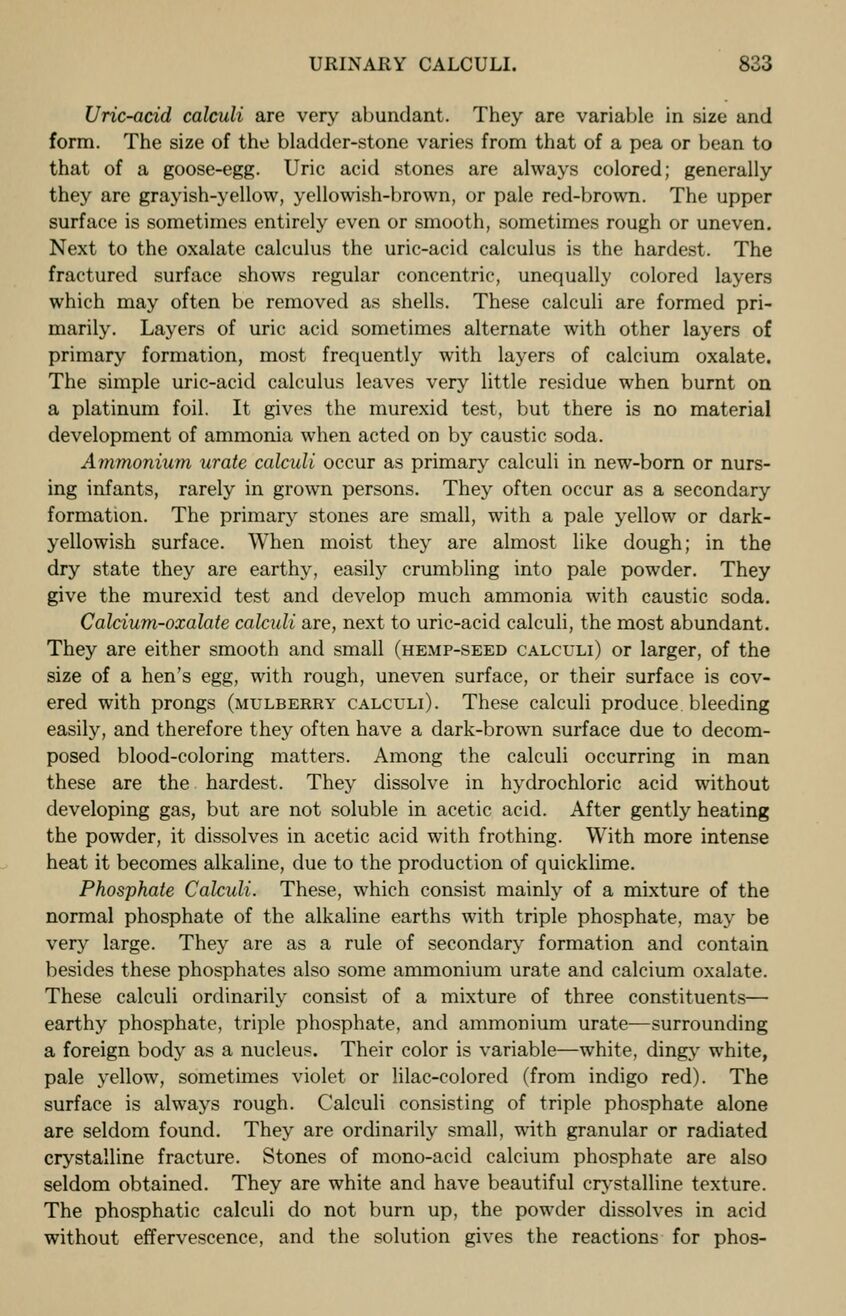
Full resolution (JPEG) - On this page / på denna sida - XIV. Urine - VII. Urinary Sediments and Calculi - Urinary Calculi

<< prev. page << föreg. sida << >> nästa sida >> next page >>
Below is the raw OCR text
from the above scanned image.
Do you see an error? Proofread the page now!
Här nedan syns maskintolkade texten från faksimilbilden ovan.
Ser du något fel? Korrekturläs sidan nu!
This page has never been proofread. / Denna sida har aldrig korrekturlästs.
URINARY CALCULI. 833
Uric-acid calculi are very abundant. They are variable in size and
form. The size of the bladder-stone varies from that of a pea or bean to
that of a goose-egg. Uric acid stones are always colored; generally
they are grayish-yellow, yellowish-brown, or pale red-brown. The upper
surface is sometimes entirely even or smooth, sometimes rough or uneven.
Next to the oxalate calculus the uric-acid calculus is the hardest. The
fractured surface shows regular concentric, unequally colored layers
which may often be removed as shells. These calculi are formed pri-
marily. Layers of uric acid sometimes alternate with other layers of
primary formation, most frequently with layers of calcium oxalate.
The simple uric-acid calculus leaves very little residue when burnt on
a platinum foil. It gives the murexid test, but there is no material
development of ammonia when acted on by caustic soda.
Ammonium urate calculi occur as primary calculi in new-born or nurs-
ing infants, rarely in grown persons. They often occur as a secondary
formation. The primary stones are small, with a pale yellow or dark-
yellowish surface. When moist they are almost like dough; in the
dry state they are earthy, easily crumbling into pale powder. They
give the murexid test and develop much ammonia with caustic soda.
Calcium-oxalate calculi are, next to uric-acid calculi, the most abundant.
They are either smooth and small (hemp-seed calculi) or larger, of the
size of a hen’s egg, with rough, uneven surface, or their surface is cov-
ered with prongs (mulberry calculi). These calculi produce bleeding
easily, and therefore they often have a dark-brown surface due to decom-
posed blood-coloring matters. Among the calculi occurring in man
these are the hardest. They dissolve in hydrochloric acid without
developing gas, but are not soluble in acetic acid. After gently heating
the powder, it dissolves in acetic acid with frothing. With more intense
heat it becomes alkaline, due to the production of quicklime.
Phosphate Calculi. These, which consist mainly of a mixture of the
normal phosphate of the alkaline earths with triple phosphate, may be
very large. They are as a rule of secondary formation and contain
besides these phosphates also some ammonium urate and calcium oxalate.
These calculi ordinarily consist of a mixture of three constituents
—
earthy phosphate, triple phosphate, and ammonium urate—surrounding
a foreign body as a nucleus. Their color is variable—white, dingy white,
pale yellow, sometimes violet or lilac-colored (from indigo red). The
surface is always rough. Calculi consisting of triple phosphate alone
are seldom found. They are ordinarily small, with granular or radiated
crystalline fracture. Stones of mono-acid calcium phosphate are also
seldom obtained. They are white and have beautiful crystalline texture.
The phosphatic calculi do not burn up, the powder dissolves in acid
without effervescence, and the solution gives the reactions for phos-
<< prev. page << föreg. sida << >> nästa sida >> next page >>